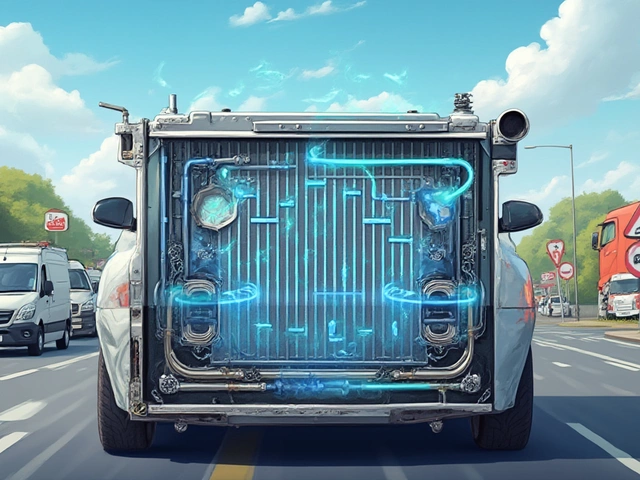Picking the correct battery for your car isn't just about matching the physical size or the voltage; it's like choosing a reliable partner for a road trip. You need dependability and compatibility to keep things running smoothly. Whether you're dealing with a modern electric vehicle or a trusty old sedan, the battery is crucial for starting your car and supporting all the electronics within it.
With the array of options available in the market, it can feel a bit overwhelming. But worry not—this guide will help you navigate the process with confidence and ease. From understanding the battery anatomy to knowing when it's time for a replacement, let's delve into the world of car batteries. It's simpler than you might think, and with a few insights, you'll be on your way to ensuring your vehicle's heart doesn’t skip a beat.
- Understanding Battery Types
- Determining Your Car's Requirements
- Reading Battery Specifications
- Common Mistakes to Avoid
- Battery Maintenance Tips
- Signs You Need a New Battery
Understanding Battery Types
When it comes to car batteries, the landscape is more varied than you might initially suspect. A common mistake many make is assuming that all car batteries are more or less the same, merely providing the juice needed to get an engine running. Yet, in reality, each type has its unique characteristics crafted to suit diverse vehicular demands. The most recognizable car battery types include lead acid, absorbed glass mat (AGM), and lithium-ion, each tailored for specific purposes and technological advancements.
Conventional Lead Acid Batteries
Lead acid batteries, often known as flooded or wet cell batteries, have been around since the 19th century. They're a testament to engineering's resilience, what with their capacity to tackle most standard internal combustion engines. Lead acid batteries are mostly used in traditional passenger vehicles due to their balance between cost and efficiency. A lead grid inside is immersed in an acidic solution, producing electricity through a reversible chemical reaction. Although these batteries have served dutifully for years, they require routine maintenance like checking water levels and ensuring no acid spills.Absorbed Glass Mat (AGM) Batteries
The modern world has seen a surge in the adoption of AGM batteries. These batteries are known for their durability and performance, especially in conditions where high power demands frequent cycling. They're often used in start-stop systems and vehicles with additional electronic accessories. Unlike their lead acid counterparts, AGM batteries are maintenance-free and resistant to vibrations, making them a solid choice for off-roaders. The trick lies in their construction, where a glass mat separates the plates to absorb the electrolyte, ensuring no spills and allowing the battery to discharge at a controlled and steady rate.Lithium-Ion Batteries
Shifting gears to even more advanced technology, lithium-ion batteries are gaining ground, particularly in electric and hybrid vehicles. These batteries excel in lightweight builds and rapid charging capabilities, which cater beautifully to the needs of the contemporary auto industry. They hold a significant charge, packed into a compact form without the weight of traditional alternatives. While not as prevalent as the other types for traditional cars, their efficiency ensures longer driving ranges and reduced environmental impacts."The choice of the right battery for your vehicle is crucial for optimum performance," says John Cook, an automotive expert. "Lithium-ion might be the future, but lead acid remains the backbone of today's vehicular ecosystem."
Understanding the different car battery types helps ensure you not only power your vehicle efficiently but also make environmental choices aligned with your values and your car's demands. Whether it's keeping the classic reliable lead acid, exploring the potent AGM, or venturing into the revolutionary realm of lithium-ion, knowledge is key to keeping your ride on the road for years to come.
Determining Your Car's Requirements
Understanding the specific requirements of your vehicle when selecting a car battery is crucial to ensure its optimal performance. Cars, much like people, have unique needs that must be met to function at their best. Begin by investigating your vehicle's owner's manual, which typically contains vital information about the compatible battery type. This should include the recommended battery group size, which relates to the physical size of the battery case, as well as the corresponding terminal locations. It's essential to ensure that the new battery fits snugly within the battery holder while having terminals that are in an easily accessible location.
The climate you drive in also plays a significant role in determining your car battery needs. Cold cranking amps (CCA) and reserve capacity (RC) are two critical specifications to examine. CCA is particularly important if you live in a cold climate because this metric measures a battery's ability to start your engine under freezing conditions. A higher CCA is advantageous when temperatures plummet. On the other hand, RC determines how long a battery can run your car should your alternator fail. A longer RC is beneficial, especially if you're using many electrical systems simultaneously.
"Equipping vehicles with the right battery is integral for long-term vehicular health," suggests Autocar UK, a respected automotive publication, emphasizing the importance of matching the battery to the vehicle's demands.
For those driving more modern cars, considerations expand beyond basic functional environments. Many newer vehicles are equipped with advanced technology requiring substantial electrical loads. Integrated systems such as start-stop fuel-saving technology call for specific types of batteries like Absorbent Glass Mat (AGM) or Enhanced Flooded Battery (EFB). These batteries offer a deep cycle capacity and better-suited energy delivery for frequent starts and stops compared to traditional lead-acid batteries.
To further simplify finding the correct battery, here's a quick checklist: check your battery's existing voltage and capacity, make a note of the preferred CCA and RC based on local conditions, and review any particular technology requirements your car might incorporate. Also, always consider purchasing the freshest battery possible, as those that sit on shelves for long periods may suffer from diminished capacity, even before they're installed. Keeping these factors in mind ensures that your choice is reliable, providing the power and longevity required for seamless vehicle operation.

Reading Battery Specifications
Understanding the car battery specifications is essential, much like deciphering a secret code that unlocks the mystery of power requirements for your vehicle. These specifications give you important clues about compatibility and performance, and knowing what each number and letter means can save you from potential headaches down the road. Typically, the battery casing will have an array of codes and numbers. One vital specification to pay attention to is the Cold Cranking Amps (CCA), which indicates the battery's ability to start an engine in cold temperatures. In regions where winters are harsh, a higher CCA can be a lifesaver, ensuring your car starts smoothly when frost rolls in.
Another key spec is the Reserve Capacity (RC). This tells you how long the car battery can keep your headlights and other accessories running without any juice from the engine. A longer RC rating means the battery can support those systems in case of a charging failure. This spec can be crucial if you enjoy road trips or often find yourself caught in traffic jams. You don’t want everything shutting down while you’re far from home. Along with CCA and RC, pay attention to the amp-hour (Ah) rating, which measures the amount of current a battery can supply for an hour at a specified voltage. Understanding this can help if your car is packed with electronic devices.
Battery Group Size
The battery group size is another aspect that many tend to overlook, perhaps because it sounds technical, but don't be daunted by the term. This specification is like the shoe size for your battery, ensuring it fits snugly in your car's battery tray. An ill-fitting battery can lead to jostling while driving, which can damage both the battery and the vehicle components. The Battery Council International (BCI) assigns these group sizes by physical dimension, terminal locations, and type of vehicle with which they are compatible. Your vehicle's owner's manual will generally mention the specific group size you need, simplifying your shopping experience.
Lastly, it’s worth noting that car batteries can have different case types, which refer to the material and how it’s built. Materials like AGM (Absorbent Glass Mat) or SLA (Sealed Lead Acid) can impact performance and lifespan. A notable example comes from a quote by the renowned automotive publication, Car and Driver:
"AGM batteries are prized for their durability and are known to last longer than traditional lead-acid types, particularly in demanding conditions."So, if you're using your vehicle heavily or often drive on rugged terrain, investing in an AGM or SLA battery might be a smart choice. Paying attention to these terms can guide you to a better decision that matches your driving habits and conditions.
Common Mistakes to Avoid
When it comes to your car battery, overlooking certain details can end up costing you time, money, and patience. One of the most frequent blunders is purchasing a battery based simply on price. While it’s tempting to save a few quid, choosing a cheap battery that isn’t suited to your vehicle's maintenance requirements may leave you stranded much sooner than you'd like. Remember, your car’s make and model dictate specific battery needs, like the right CCA (Cold Cranking Amps) and the reserve capacity. Getting these wrong means risking unreliable starts and shortened battery life.
Another misstep is neglecting the battery post-purchase, taking for granted that it's maintenance-free. Even the most advanced batteries can benefit from regular checks. Dirt, corrosion, and loose connections are silent killers, often leading to poor electrical flow and early failure. Keep your terminals clean and inspect them periodically for tightness and corrosion. Speaking of connections, improper installation is a common error that can cause unnecessary headaches. Always ensure your battery is securely mounted to minimize vibrations that can damage internal battery components over time.
Carrying on, ignoring the

Battery Maintenance Tips
Maintaining your car battery, much like watering a beloved houseplant, ensures it stays healthy and prolongs its life. A well-maintained car battery is less likely to fail unexpectedly, leaving you stranded. One of the first tips is to keep the battery clean and dry. Dirt and moisture can create conductive paths that drain the battery even when the car is off. Regularly inspect your battery terminals and cables to make sure they are tight and free from corrosion. A solution of baking soda and water can do wonders to clean any build-up on the terminals. Gently scrub with an old toothbrush to remove this corrosion, and then rinse with water. This simple routine can keep the connections strong and efficient.
Another vital aspect of vehicle maintenance is to check the battery’s charge level. Most modern batteries are maintenance-free, yet some still come with removable caps. If yours is the latter, peek inside to ensure that the electrolytes cover the battery plates. Distilled water can be added if the level is low. For those with sealed batteries, investing in a multimeter might be a wise choice. They offer an easy and quick way to check the voltage and make sure the charge is in its optimal range, around 12.6 volts for a fully charged battery. With colder months, batteries tend to discharge more quickly, which these frequent checks can help you catch in time.
Keeping all electronics off when the car isn’t running is another peculiar but effective battery-saving habit. It’s not just about turning off the headlights—a common culprit of a dead battery—but also HVAC fans, interior lights, and even unplugging phone chargers. These small practices can collectively extend the lifespan of your car battery significantly. Regular driving also impacts battery health positively. Leaving your car inactive for extended periods can let the battery lose its charge capacity entirely. Experts recommend starting the engine at least once a week, allowing the alternator to recharge the battery.
"A car battery's best friend is regular exercise," notes John Morgan, a veteran automotive technician. "It keeps the electrons flowing and the battery happy."
Investigate your car for any unusual electrical drain, often called a parasitic draw, if your battery keeps dying. This often involves checking things not easily seen. Is the glove box light staying on? What about the boot light? A quick way to check is to shut these compartments and feel if they remain warm. Presence of heat might signify the light bulb is burning unnecessarily. It's a straightforward approach but can save significant headache and prevent the battery from discharging when least expected.
If necessary, make a point to have your battery tested by professionals at least twice a year—ideal times might be right before the blazing heat of summer and the frosty chills of winter. Many auto shops offer this service for free and provide insights into whether it's time for a replacement. And if you find yourself needing a replacement, take this as an opportunity to research car battery options suitable for your vehicle. Keeping these tips in mind, your battery will not only function optimally but also last longer than you'd expect.
Signs You Need a New Battery
Knowing the signs that indicate when you need a new car battery can save you from the inconvenience of being stranded unexpectedly. The most obvious indicator is your engine's inability to start. When you turn the key and hear a clicking sound without the engine cranking, it often points to a weakened battery struggling to supply enough power. Many drivers assume it's an issue with the starter, but in reality, a weak battery commonly masquerades as larger mechanical failures. If you notice your headlights are dim, especially when your car is idling, it's another sign the battery might be on its last legs. Lights require steady power, and dimness can mean your battery is unable to maintain power since it’s being drained for other essential functions.
Pay attention to sudden electrical malfunctions too. If your car's electronics, like the radio or electric windows, are acting erratically, it might correlate to a declining battery. Batteries power all your vehicle’s electronics, and if they're inconsistent, it suggests a disruption in power supply. Another red flag could be an illuminated check engine light. Many people overlook this clue to potential battery problems because it can mean various issues. However, it's worth considering if coupled with other symptoms. Witnessing constant battery replacements could suggest a deeper issue, perhaps an alternator that's not charging sufficiently, shortening the battery's life.
While diagnostics by a professional can pinpoint the exact cause, using a voltmeter at home is a handy assessment tool. A healthy battery reads between 12.4 and 12.7 volts when the car isn't running. If you’re getting constant below-average readings, a replacement is most likely on the horizon. Cold mornings exacerbating starting problems might be the proverbial writing on the wall. Batteries gradually lose their ability to hold charge over time, particularly when exposed to extreme temperatures. If cold weather impacts your battery's longevity more than before, consider it a cue to begin seeking a new one. It's insightful to remember Henry Ford's words when he said,
‘Failure is simply the opportunity to begin again, this time more intelligently.’Recognizing these signs means you can act wisely and avoid being left high and dry.






